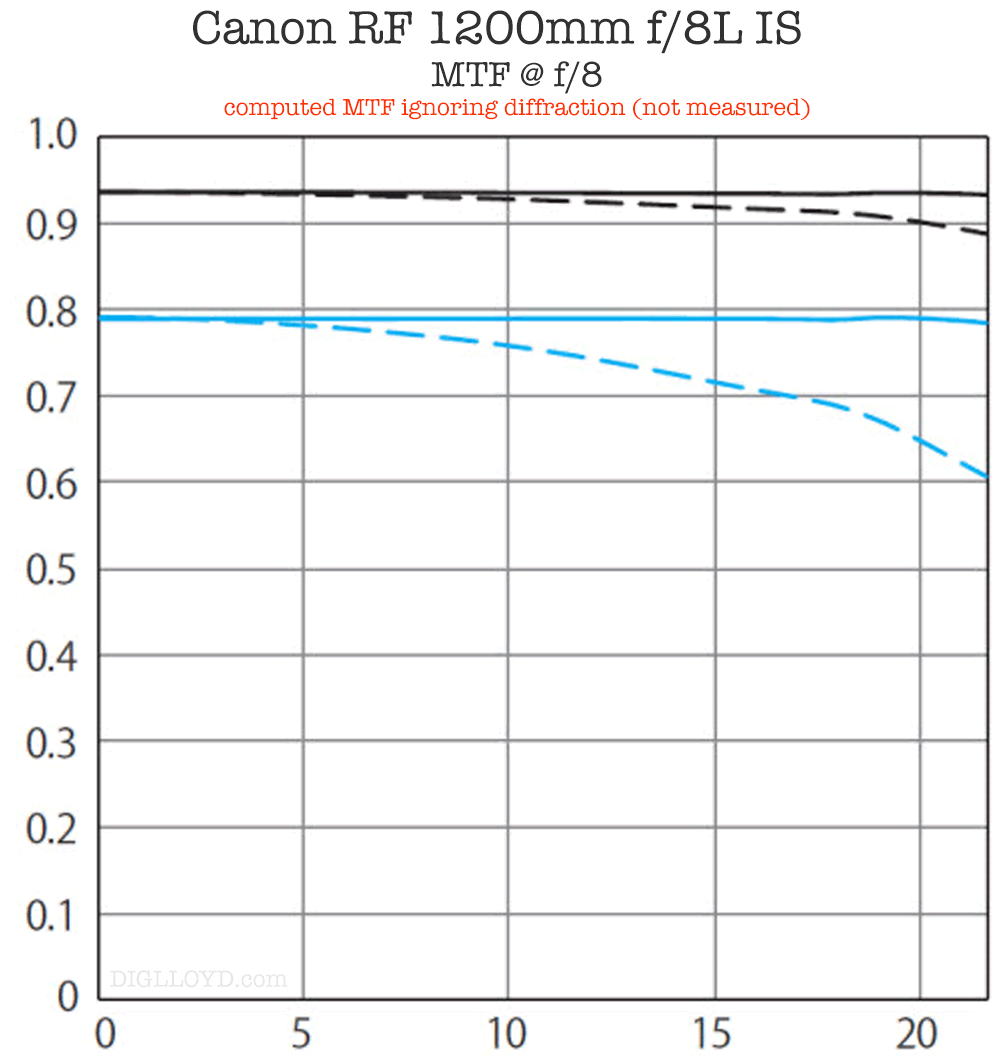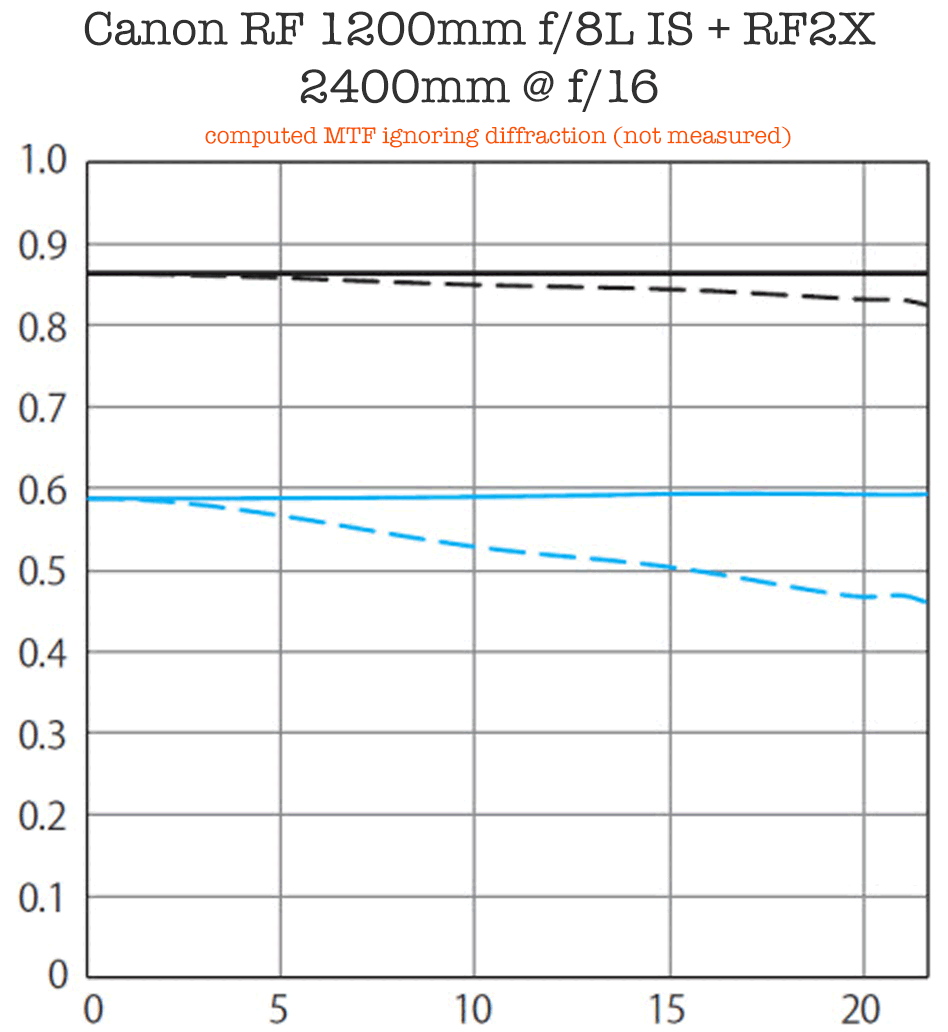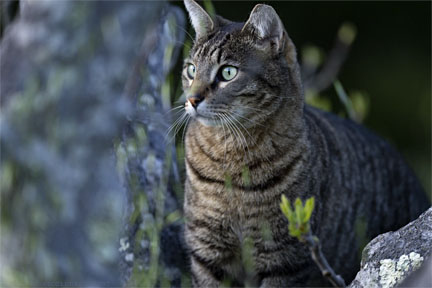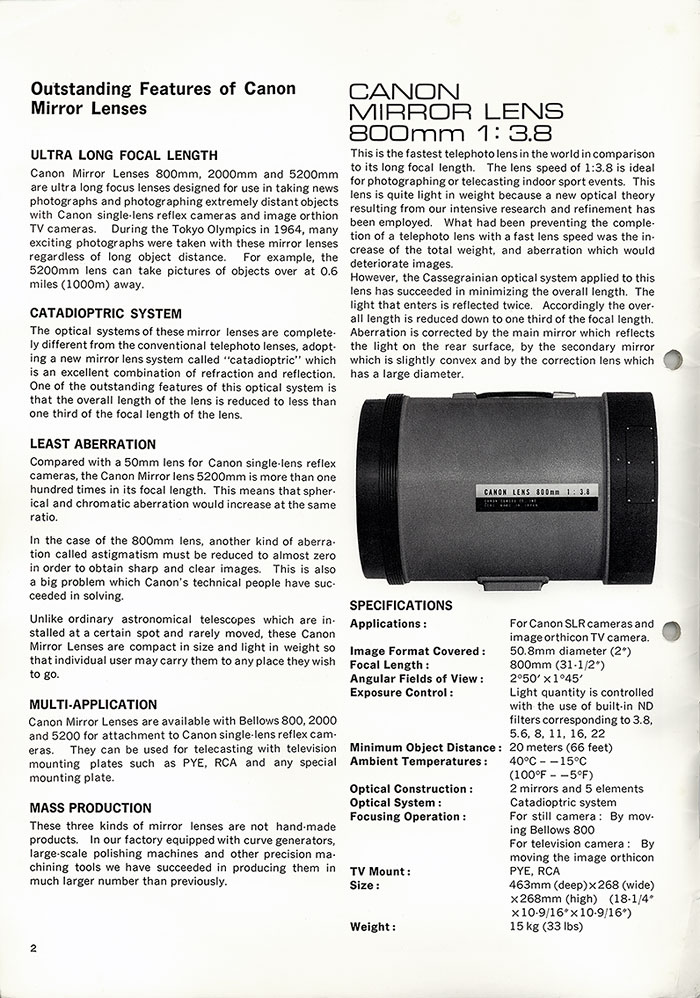Canon Goes with the Big Artillery: Canon RF 800mm f/5.6L IS, Canon RF 1200mm f/8L IS
re: Sony A1 Animal Eye AF with the Sony FE 600mm f/4 GM OSS
At $19999, I won’t be picking up the new Canon RF 1200mm f/8L IS any time soon. Ditto for the $16999 Canon RF 800mm f/8L IS.
What are they for? I’m actually not sure... birds, wildlife, sports? Because shooting through much air will be like shooting through a wavering haze—atmospheric distortion is a heavy hand on image quality. Canon’s sample pictures shown only sports, so that seems to be the idea.
And I have to wonder: why would one not prefer the Canon RF 600mm f/4L IS along with the 2X teleconverter, which would equate to a 1200mm f/8? More flexible, much lower cost.
One has to presume that the 1200/8L offers superior performance. Except that Canon’s own MTF charts for the 600/4 + RF2X show it to be as good a performer as the 1200mm f/8 (negligible difference).

2400mm f/16
A 1200mm is really difficult to shoot for sharp pictures, but the 1200mm f/8 + TC2X yields an ''insane' 2400mm f/16. A sharp picture will require a very high sutter speed and the IS turned on and electronic shutter—quite a challenge. Well, I guess that’s what digital ISO is for.
But the Canon MTF charts are fantasy MTF since they are diffraction-free. At f/16 all fine detail is turned to mush and overall contrast will be dull, via diffraction dulling.
Canon MTF tests are performed only at wide-open aperture As noted previously, Canon’s engineers now publish MTF tests on Canon lenses exclusively at one aperture: wide-open. You cannot, for instance, determine from the available MTF data whether and to what degree optical performance at the smallest aperture, such as f/22, might suffer from the results of diffraction, nor whether there are significant benefits to be had by stopping down from a lens’ widest aperture by two or three stops.


 MTF for Canon RF 1200mm f/8L IS USM
MTF for Canon RF 1200mm f/8L IS USM
Why not a zoom?
Something like an 600 to 1200mm zoom or 800 to 1200mm zoom would be a lot more useful in general. But clearly Canon thinks this market needs serving—all good.
Continues...
Reach matters
Images below using the fanastic Sony FE 600mm f/4 GM OSS.
Sometimes 600mm is enough, and sometimes 1200mm would get the job done better. For example, this Western Bluebird shot vertically at 1200mm would have been perfect. And rarely can I get this close.

Sony A1 + Sony FE 600mm f/4 GM OSS
RAW: LACA corrected, push 1 stops, +40 Whites, +30 Dehaze, +10 Clarity, Chroma NR {5}, USM {8,50,0}
western bluebird Sialia mexicana
[low-res image for bot]
Below, this shot of beautiful Tigger is very nice, but a 1200mm wouild allow closer cropping, which even for a formerly feral housecat is useful (changing behavior by getting too close).

Sony A1 + Sony FE 600mm f/4 GM OSS
RAW: LACA corrected, pull 0.17 stops, +30 Whites, -20 Blacks, +10 Contrast, +10 Dehaze, +10 Clarity, Chroma NR {8}
[low-res image for bot]
And sometimes 600mm is just right.

Sony A1 + Sony FE 600mm f/4 GM OSS
RAW: LACA corrected, pull 0.45 stops, +20 Whites, -20 Blacks, +20 Dehaze, +10 Clarity, Chroma NR {8}
[low-res image for bot]
Roy P writes:
As much as 1200mm prime sounds impressive, unless it is an exceptionally clear, cool day with zero thermal effects, most of the time, in most places on earth, you’d be shooting through a wall of jello at 1200mm. I think a dedicated 1200mm lens would have very limited utility. I can’t believe this being a huge market, and even if some enthusiasts ended up buying one of these for $20K, I suspect they will soon tire of it.
I think it makes far more sense to build a super-high quality 2.0x extender, so a 400/2.8 can become an effective 800/5.6, and a 600/4 can become an effective 1200/8 with minimal compromise in optics or AF/tracking speed. Even if such a 2.0x TC costs say, a whopping $2000, that would still make a 600/4 lens + TC = about $15,000 vs. the $20,000 Canon wants for its dedicated 1200/8.
All the big guys – Sony, Canon, Nikon – have had excellent 1.4x extenders for years. You can put one of these on a 600/4 and barely feel its effects in either acquiring focus or tracking or optics. But all have had so-so 2.0x extenders, not sure why. Maybe it’s hard to get a 4x magnification from an add-on lens that is not integrated into the stack?!
[later]
...Birders are certainly a big market. To get these skittish little birds, you really need the extra focal length.
But it still seems to me a super high quality 2.0x would offer far more flexibility than a dedicated 1200/8. But if birding is the primary use case, maybe a dedicated 1200mm is the way to go.
Well, so a 1200/8 may be the next big thing from Sony, and we can guess its specs already: 10 grams lighter than the Canon and $0.95 more expensive. Canon priced at $19,999, so it doesn’t give Sony much room to be a little more expensive (“obviously, must be better”), and still remain under $20K.
Lovely bird shot, btw! What’s really amazing about these ultra long focal lengths is the way they can reduce any background into a lovely wash of colors, if you can put some distance between your subject and the background. As the foliage is, in your photo.
DIGLLOYD: atmospheric distortions are a severe problem even for a 400mm lens. Even 100 meters out, the effects start showing up on a hot day. Farther, and the entire image starts looking like a smeared finger painting.
My guess is that the 800/5.6 and 1200/8 will offer noticeably superior performer to their equivalents using teleconverters on shorter lenses.
My all-around top choice would be a 600/4, plus cropping as needed. Which is why a 100-megapixel camera could really help. The TC1.4X and TC2X converters are pretty solid, but one cannot be swapping them very often.
Ed A writes:
You note that the performance of Canon's new 1200mm f/8 lens is about the same as the 600mm f/4 with their 2x teleconverter. As I understand it, that is not a coincidence! The new product is the old lens with a teleconverter and RF mount adaptor glued on. Check the diagram of lens elements. I think that similarly the 800mm lens is a 400mm with 2x.
DIGLLOYD: even the rear end of the lens looks that way.
Phil A writes:
Old (Canon FT era) brochure and some snaps from back in the mid ‘80s using the NFD1200F5.6L (with built in 1.4Ext).
DIGLLOYD: we’ve come a long way. Check out this PDF of the Canon mirror lenses from the 1960s (the three images at the end with the 1200/5.6L are from the 1980s).








































